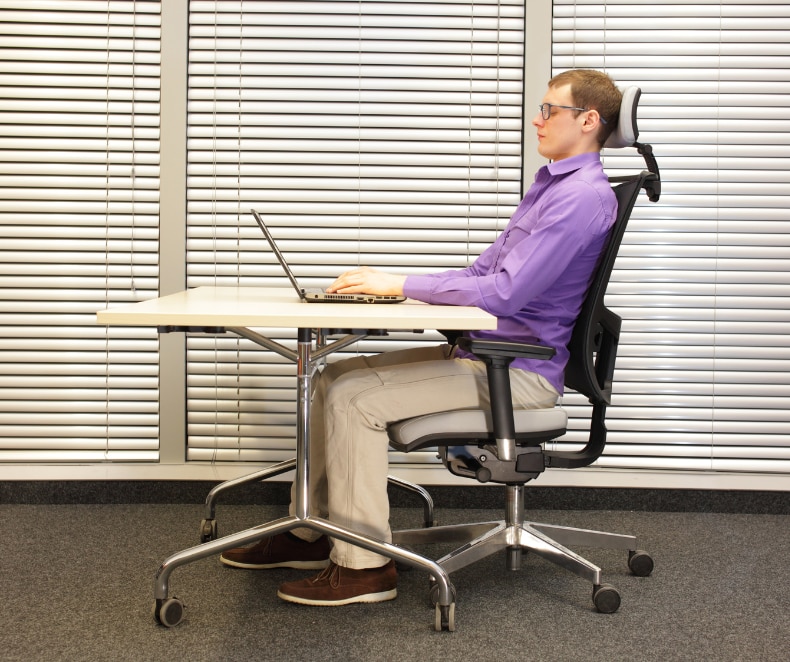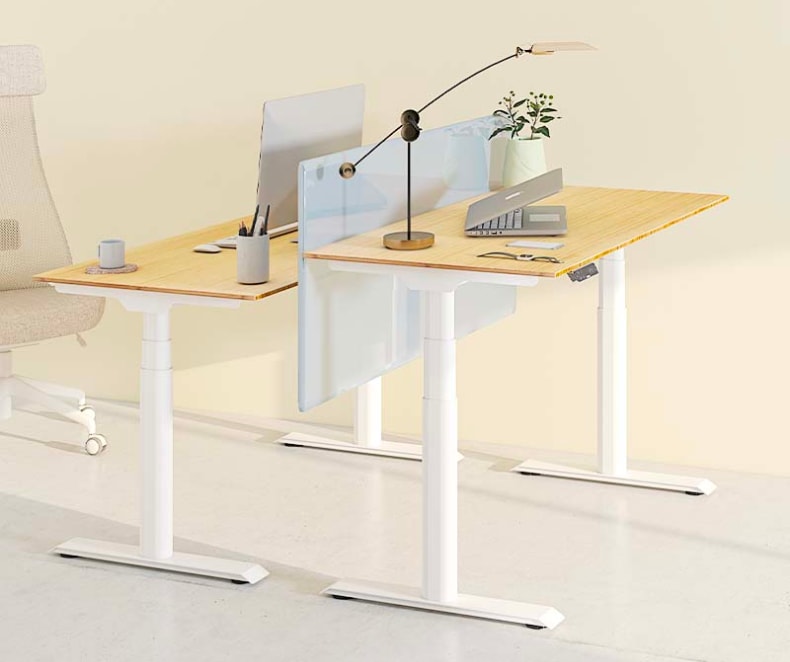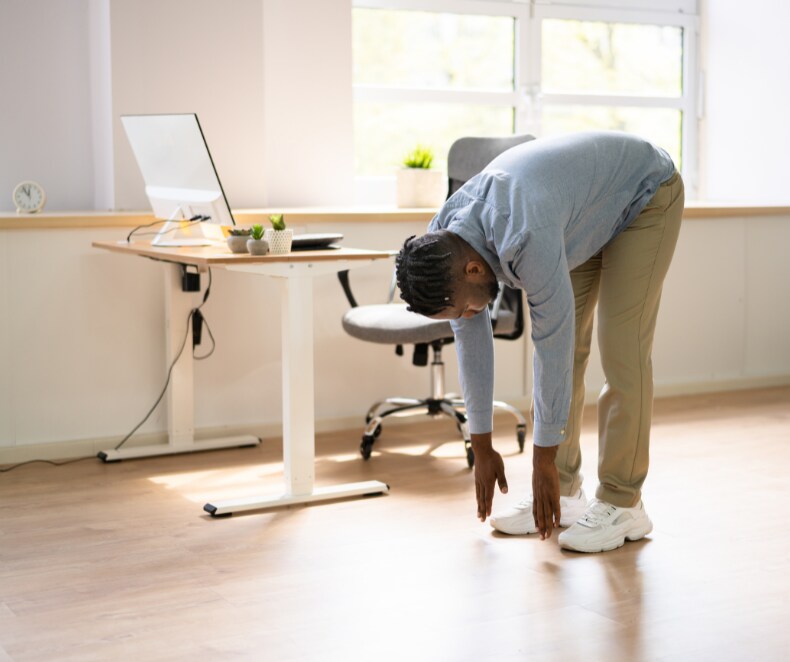For many of us, the modern workplace means being glued to a chair for long periods. This can cause all sorts of physical problems in our bodies that manifest as pain. If you find yourself suffering from back, neck, shoulder, leg, or wrist pain while clocking in those desk hours, it's worth investigating whether your workspace is causing it.
The wrong kind of chair and poor posture are two major culprits when it comes to workplace-induced aches and pains. Sitting for too long in the same position causes our muscles to become tight and strained - leading to stiffness, aches, and pains. But if you choose an ergonomically designed chair with adjustable lumbar support, this could be reduced significantly.
Problems Caused by Prolonged Sitting
Prolonged sitting can cause a range of problems, from poor circulation to increased risk for chronic illnesses such as diabetes and heart disease. It can also lead to an imbalance in your spine called forward head posture, where the upper back and neck curve inward instead of remaining flat and straight.
This causes strain on the muscles in our neck and shoulders, resulting in pain. Another issue is sitting with your legs crossed, which leads to hip flexors become tight and restricted - resulting in lower back discomfort.
When muscles are strained, they often become inflamed and tender - leading to pain. This can be especially true if your job requires you to focus on a computer screen for long periods, as the strain on your eyes causes tension in the head and neck muscles. Other postural problems that can arise from sitting for too long include rounded shoulders (which push your spine out of alignment) and weak core muscles (which make it harder to maintain correct posture).
You can reduce or even eliminate this kind of pain by making a few adjustments in how you work. Try setting up an ergonomic workspace with adjustable chairs, tables, and monitors to help improve posture, lessen eyestrain, and promote good circulation. Additionally, changing positions every hour or so can help reduce the strain on your muscles. Finally, try incorporating stretching exercises into your routine to keep your body loose and limber.

How To Correct Posture to Avoid Pain?
Good posture is essential for reducing pain and avoiding other potential health issues. Here are some tips to help you improve your posture in the workplace:
Keep Your Back Straight
Maintaining a good posture is essential for reducing pain and promoting a healthy lifestyle. This means keeping your back straight, with your spine in a neutral position. To do this, make sure you sit up tall so that the chair's lumbar support supports your lower back. Also, keep your shoulders relaxed and avoid hunching or slouching.
Sit Up Tall with Your Feet Flat on The Floor
Sitting up tall with your feet flat on the floor helps keep your spine in alignment and will reduce any strain caused by sitting in an awkward pose for too long. Try to keep your knees at a 90-degree angle to maintain good posture and avoid putting pressure on other parts of your body.
Adjust The Height of Your Monitor
Your monitor should be at a distance where you can see everything without leaning forward or strain your eyes. It is also important to ensure that the monitor's height is at eye level so that you don't have to look down or up too much while working.
Adjust Your Mouse and Keyboard Height
The mouse and keyboard should be set up to allow for proper ergonomic posture - meaning no straining or reaching. Make sure the keyboard is slightly below elbow level and tilted towards the user, and the mouse should be positioned where it feels comfortable when using it - usually just above wrist level.
Take Frequent Breaks
Finally, it is important to take frequent breaks throughout the day. Even if you don't feel any pain, taking a few minutes away from your work can help alleviate tension and prevent future aches. This can be as simple as getting up for a short walk or stretching during your break, which will help keep your body feeling good.

Alternatives to Traditional Office Furniture
To make your workspace pain-free, you may need to consider changing your furniture. Several ergonomic solutions are available to help make your workspace safer, more comfortable, and more productive. Let us take a look at some of them.
Adjustable Desk vs. Traditional Desk
An adjustable desk can help you find the perfect height for your keyboard and monitor while also allowing you to switch between sitting and standing throughout the day. This will reduce strain on your neck, back, arms and legs - easing pain and boosting productivity.
Ergonomic Chair vs. Traditional Desk Chair
An ergonomic chair is designed to be adjustable to best fit your body type and relieve any pressure points. They provide lumbar support and armrests and often feature a reclining or tilting mechanism, which can help reduce strain on the spine.
Standing Desk vs. Sitting Desk
If your job requires you to sit for long periods, it may be worth investing in a standing desk. These desks allow you to stand while working, easing the pressure on your spine and reducing any aches or pains associated with sitting. Adjustable standing desks allow you to switch between sitting and standing throughout the day.
Investing in some of these ergonomic solutions can ensure you're sitting comfortably while working, reducing the chances of experiencing aches or pains. It is also important to remember that even with the best furniture, it is still essential to take frequent breaks and practice proper posture to prevent pain.

Oval-Shaped Standing Desk E8
The Standing Desk E8 is the perfect solution for those who work at home or in the office and want to break their bad posture habit. The oval-shaped legs add to the aesthetics of your workspace without compromising stability and strength.
The desk has a dual-lifting motor system, which allows smooth and easy transitions even when it is at its full weight capacity of 275 pounds and its maximum height of 49.2 inches. The motors are controlled using a multifunction touch keypad with a touchscreen display and touch-sensitive buttons.
The E8 comes equipped with a cable management system that helps you keep pesky wires and cables tucked out of sight, keeping your workspace neat.

Tips For Staying Healthy While Working a Sedentary Job
Staying healthy during a sedentary job can be challenging - especially when you are stuck in front of a computer for hours on end! Here are some tips on how to stay healthy while working from home:
1. Get up and walk around every hour: It is important to take small breaks throughout the day by walking around or stretching. This helps to keep your blood flowing, reducing any aches caused by sitting in one position for too long.
2. Stretch regularly throughout the day: Regular stretching helps relieve tension from your muscles, especially those holding you in a fixed posture while working.
3. Find time to exercise outside of work: Sitting at a desk all day can be mentally and physically draining - making it harder to find the motivation to exercise after hours. Try scheduling regular workouts into your daily routine to stay consistent with your physical activity goals.
4. Have healthy snacks and drinks available: Make sure you have healthy snacks and drinks on hand throughout the day to help keep your energy levels up and to prevent unhealthy cravings.
5. Make sure your workspace is ergonomically correct: Investing in ergonomic furniture can help reduce any aches or pains associated with sitting for long periods. Ensure that your desk, chair, and monitor are all properly adjusted to fit your body type.
6. Take breaks to help relieve stress: Regular breaks throughout the day allow you to recharge mentally and physically, keeping you feeling refreshed and energized while working. Use this time to get up from your desk, take a short walk around the office, or do some simple stretching exercises.
Final Thoughts
Sitting for long periods and in the wrong postures can cause aches and pains. Investing in ergonomic furniture, taking frequent breaks, and adjusting your posture can help reduce the effects of working a desk job. Additionally, staying mindful with healthy snacks and drinks and finding time to exercise outside of work can help you stay energized throughout the day. All these measures will help keep you comfortable working from home or in the office.
By working smarter, not harder, you can protect yourself from discomfort and pain caused by prolonged sitting in the wrong position. With a few simple adjustments - both in posture and workspace setup - you'll be well on your way to enjoying a more comfortable workday.